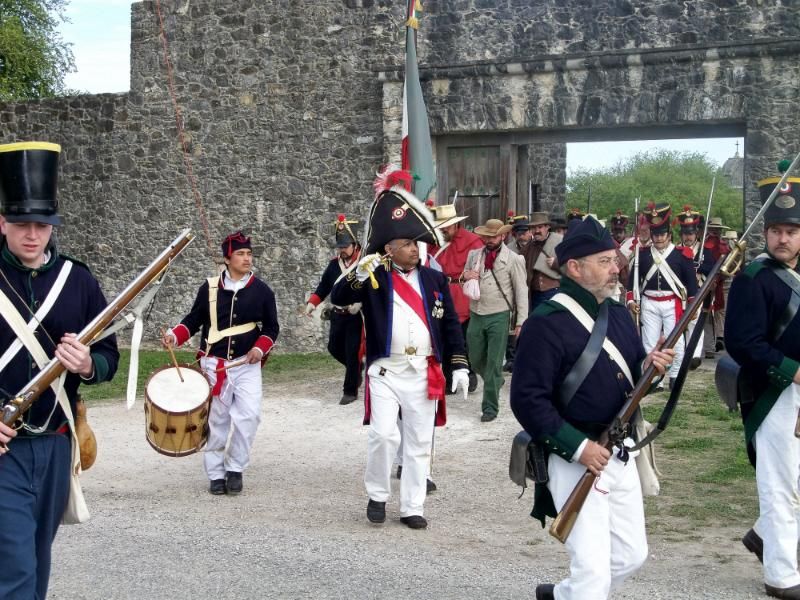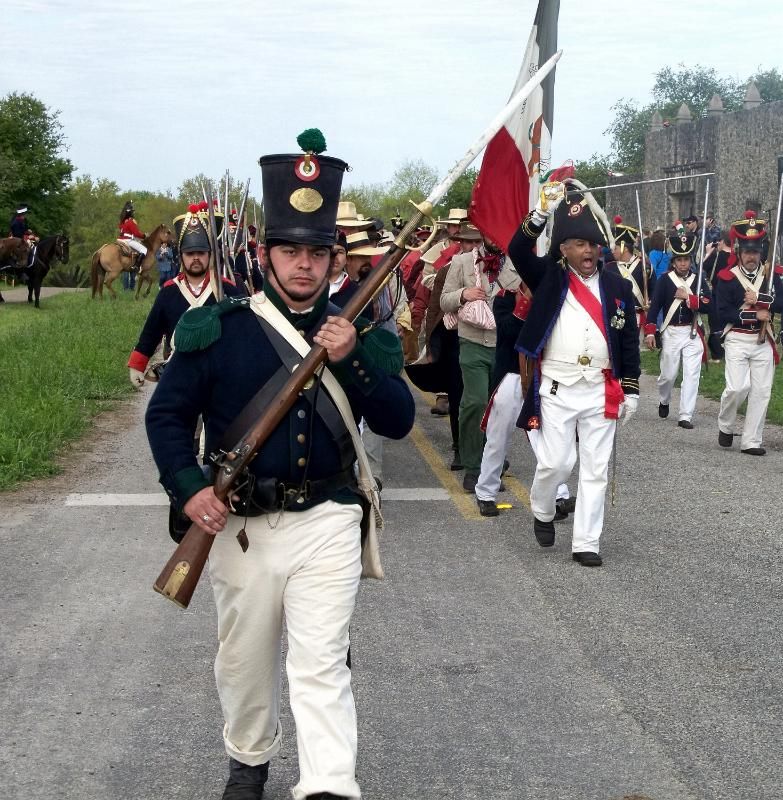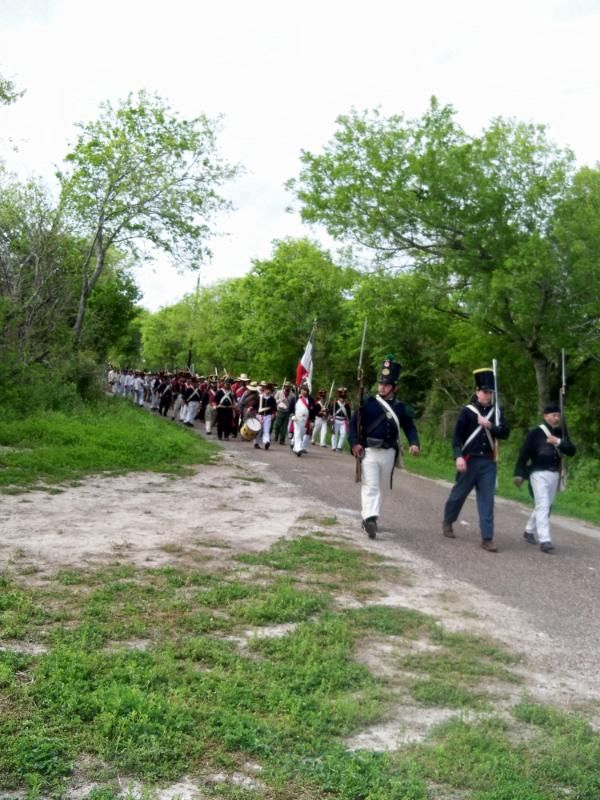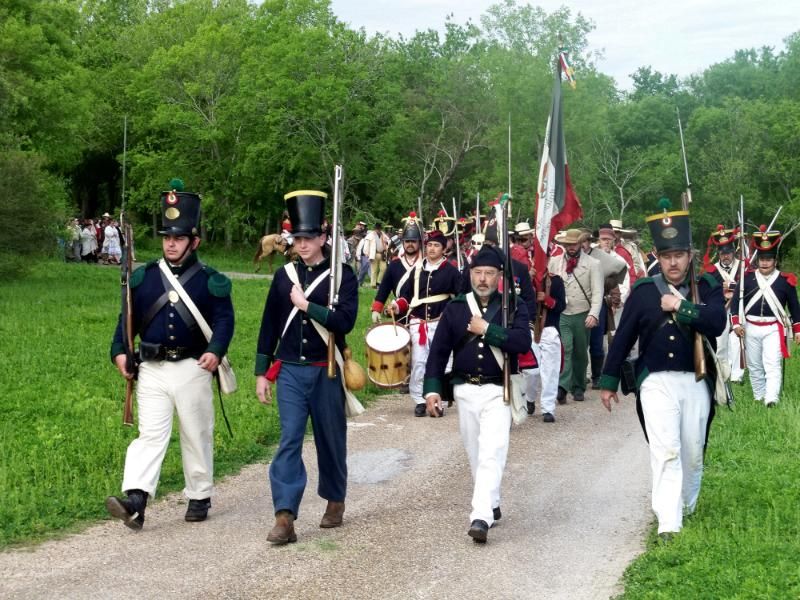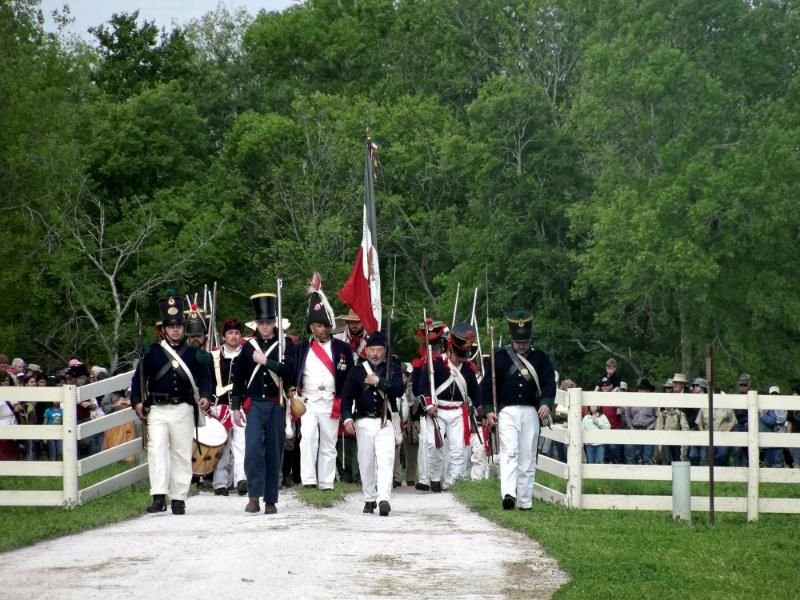Post by neferetus on Mar 27, 2006 14:44:38 GMT -5
Today is the anniversary of the "Goliad Massacre". Remember...
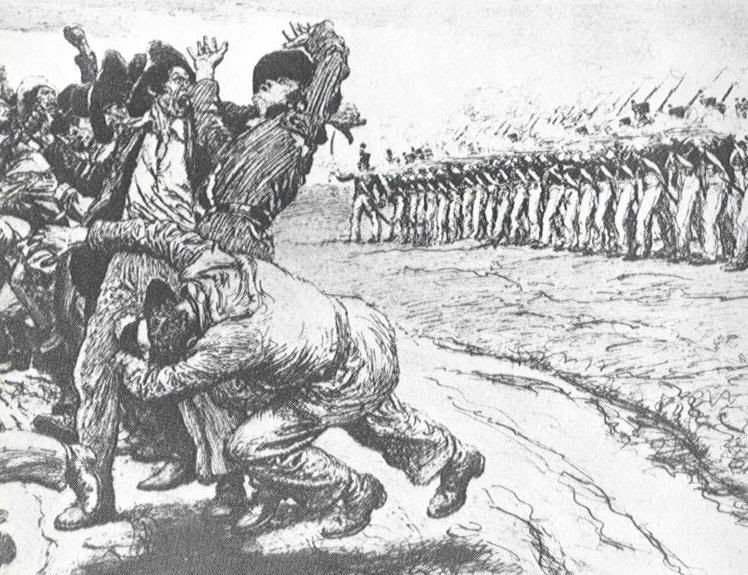
THE GOLIAD MASSACRE (from the Handbook of Texas History)
On the whole, that in shooting these prisoners, Mexico was acting within its rights. Believing that he had found an effective deterrent to expected American help for Texas, Santa Anna sought and obtained from the Mexican Congress the decree of December 30, 1835, which directed that all foreigners taken in arms against the government should be treated as pirates and shot.
Santa Anna's main army took no prisoners; execution of the murderous decree of December 30, 1835, fell to Gen. José de Urrea, commander of Santa Anna's right wing. The first prisoners taken by Urrea were the survivors of Francis W. Johnson' party, captured at and near San Patricio on February 27, 1836 Urrea, according to his contemporary Reuben M. Potter, "was not blood thirsty and when not overruled by orders of a superior, or stirred by irritation, was disposed to treat prisoners with lenity." When the Mexican general reported to Santa Anna that he was holding the San Patricio prisoners, Santa Anna ordered Urrea to comply with the decree of December 30. Urrea complied to the extent of issuing an order to shoot his prisoners, along with those captured in the battle of Agua Dulce Creek, but he had no stomach for such cold-blooded killing; and when Father Thomas J. Malloy, priest of the Irish colonists, protested the execution, Urrea remitted the prisoners to Matamoros, asking Santa Anna's pardon for having done so and washing his hands of their fate.
At Refugio on March 15, 1836, Urrea was again confronted with the duty of complying with the fatal decree of December 30. Thirty-three Americans were captured in the course of the fighting at Nuestra Señora del Refugio Mission, half of them with Capt. Amon B. King's company, the others "one by one". King and his men had infuriated their enemies by burning local ranchos and shooting eight Mexicans seated around a campfire, and these enemies were clamoring for vengeance. Urrea satisfied his conscience by shooting King and fourteen of his men, while "setting at liberty all who were colonists or Mexicans."
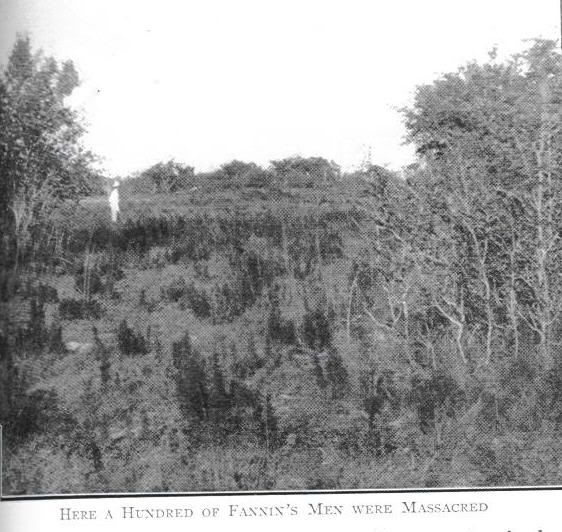
A more difficult situation confronted him on March 20 after James W. Fannin's surrender. Fannin's men had agreed upon and reduced to writing the terms upon which they proposed to capitulate. The gist of these was that Fannin and his men, including his officers and the wounded, should be treated as prisoners of war according to the usages of civilized nations and, as soon as possible, paroled and returned to the United States. In view of Santa Anna's positive orders, Urrea could not, of course, accede to these terms, but refusing them would mean another bloody battle. Fannin's men possessed, besides their rifles, 500 spare muskets and nine brass cannons and, if told that it would mean death to surrender, could sell their lives at fearful cost and might cut their way through Urrea's lines. When the Mexican and Texan commissioners seeking surrender terms failed to agree, Urrea shortened the conference by dealing directly with Fannin and proposing written terms, under which the Texans should give up their arms and become prisoners of war "at the disposal of the Supreme Mexican Government." He assured Fannin that there was no known instance where a prisoner of war who had trusted to the clemency of the Mexican government had lost his life, that he would recommend to General Santa Anna acceptance of the terms proposed by Fannin's men, and that he was confident of obtaining Santa Anna's approval within a period of eight days. Fannin, who could not have done much else-Urrea had received reinforcements and artillery that would have devastated the Texan position in an open prairie on ground lower than the Mexican lines-accepted Urrea's proposals but did not inform his men of the conditional nature of these terms. On the other hand, Maj. Juan José Holsinger, one of the Mexican commissioners, lulled their suspicions by entering the Texan lines with the greeting, "Well, gentlemen! In eight days, home and liberty!"
Fannin's men delivered up their arms, and some 230 or 240 uninjured or slightly wounded men were marched back to Goliad and imprisoned in the chapel of Nuestra Señora de Loreto Presidio at La Bahía,qv the fort they had previously occupied. The wounded Texans, about fifty (some estimates are much higher) including doctors and orderlies, Colonel Fannin among them, were returned to Goliad over the next two days. On March 22 William Ward, who with Amon B. King had been defeated in the battle of Refugio, surrendered near Dimitt's Landing on the terms accorded Fannin, and he and about eighty of his men of the Georgia Battalion were added to the Goliad prisoners on March 25. Urrea, in compliance with his promise, wrote to Santa Anna from Guadalupe Victoria, informing him that Fannin and his men were prisoners of war "at the disposal of the Supreme Mexican Government" and recommending clemency; but he reported nothing in his letter of the terms that Fannin and his men had drafted for their surrender.
Santa Anna replied to Urrea's clemency letter on March 23 by ordering immediate execution of these "perfidious foreigners" and repeated the order in a letter the next day. Meantime, on March 23, evidently doubting Urrea's willingness to serve as executioner, Santa Anna sent a direct order to the "Officer Commanding the Post of Goliad" to execute the prisoners in his hands. This order was received on March 26 by Col. José Nicolás de la Portilla, whom Urrea had left at Goliad. Two hours later Portilla received another order, this one from Urrea, "to treat the prisoners with consideration, and especially their leader, Fannin," and to employ them in rebuilding the town. But when he wrote this seemingly humane order, Urrea well knew that Portilla would not be able to comply with it, for on March 25, after receiving Santa Anna's letter, Urrea had ordered reinforcements that would have resulted in too large a diminution of the garrison for the prisoners to be employed on public works.
Portilla suffered an unquiet night weighing these conflicting orders, but he concluded that he was bound to obey Santa Anna's order and directed that the prisoners be shot at dawn. At sunrise on Palm Sunday, March 27, 1836, the unwounded Texans were formed into three groups under heavy guard commanded by Capt. Pedro (Luis?) Balderas, Capt. Antonio Ramírez, and first adjutant Agustín Alcérrica (a colonel in the Tres Villas Battalion in April 1836). The largest group, including what remained of Ward's Georgia Battalion and Capt. Burr H. Duval's company, was marched toward the upper ford of the San Antonio River on the Bexar road. The San Antonio Greys, Mobile Greys, and others were marched along the Victoria road in the direction of the lower ford. Capt. John Shackelford's Red Rovers and Ira J. Westover's regulars were marched southwestwardly along the San Patricio road. The guard, which was to serve also as a firing squad, included the battalions of Tres Villas and Yucatán, dismounted cavalry, and pickets from the Cuautla, Tampico, and Durango regiments.
The prisoners held little suspicion of their fate, for they had been told a variety of stories-they were to gather wood, drive cattle, be marched to Matamoros, or proceed to the port of Copano for passage to New Orleans. Only the day before, Fannin himself, with his adjutant general, Joseph M. Chadwick, had returned from Copano, where, accompanied by Holsinger and other Mexican officers, they had tried to charter the vessel on which William P. Miller's Nashville Battalion had arrived earlier (these men had been captured and imprisoned at Goliad, also). Although this was really an attempt by Urrea to commandeer the ship, the vessel had already departed. Still, Fannin became cheerful and reported to his men that the Mexicans were making arrangements for their departure. The troops sang "Home Sweet Home" on the night of March 26.
At selected spots on each of the three roads, from half to three-fourths of a mile from the presidio, the three groups were halted. The guard on the right of the column of prisoners then countermarched and formed with the guard on the left. At a prearranged moment, or upon a given signal, the guards fired upon the prisoners at a range too close to miss. Nearly all were killed at the first fire. Those not killed were pursued and slaughtered by gunfire, bayonet, or lance. Fannin and some forty (Peña estimated eighty or ninety) wounded Texans unable to march were put to death within the presidio under the direction of Capt. Carolino Huerta of the Tres Villas battalion.
From two groups shot on the river roads, those not instantly killed fled to the woods along the stream, and twenty-four managed to escape. The third group, on the San Patricio road, was farther from cover; only four men from it are known to have escaped. A man-by-man study of Fannin's command indicates that 342 were executed at Goliad on March 27. Only twenty-eight escaped the firing squads, and twenty more were spared as physicians, orderlies, interpreters, or mechanics largely because of the entreaties of a "high bred beauty" whom the Texans called the "Angel of Goliad", and the brave and kindly intervention of Col. Francisco Garay. Many of those who eventually escaped were first recaptured and later managed a second escape. Two physicians, Joseph H. Barnard and John Shackelford, were taken to San Antonio to treat Mexican wounded from the battle of the Alamo; they later escaped.
Portilla wrote that the total number of his prisoners was 445, exclusive of William P. Miller's eighty men, who had been captured without arms at Copano and were thus to be spared. Texan sources specify the number of prisoners as 407, exclusive of Miller's men. This may have been correct. Some of the prisoners taken at Refugio but not executed with King's men are known to have been at Goliad, where they were again spared because they were serving the Mexican army as blacksmiths, wheelwrights, or other artisans. The exact fate of others captured at Refugio is not known. They may have been added to the prisoners at Goliad and killed with Fannin on March 27. Urrea detained about twenty of Ward's men to build boats at Guadalupe Victoria, and Señora Alavez intervened with her husband, Col. Telesforo Alavez, whom Urrea left in charge of this village, to spare their lives as well; they afterward escaped. About a week after the Goliad killings, Santa Anna ordered the execution of Miller and his men and the others who had been spared at Goliad, but he rescinded the order the next day. The men were marched instead to Matamoros after the battle of San Jacinto. Though some managed to escape en route, most remained there until the Mexican government later released them.
After the executions the bodies were burned, the remains left exposed to weather, vultures, and coyotes, until June 3, 1836, when Gen. Thomas J. Rusk, who had established his headquarters at Victoria after San Jacinto and was passing through Goliad in pursuit of Gen. Vicente Filisola'sqv retreating army, gathered the remains and buried them with military honors. Some of the survivors attended the ceremony.
The common grave remained unmarked until about 1858, when a Goliad merchant, George von Dohlen, placed a pile of rocks on what was believed to be the site. In April 1885 a memorial was finally erected, in the city of Goliad rather than on the site, by the Fannin Monument Association, formed by William L. Hunter, a massacre survivor. In 1930 some Goliad Boy Scouts found charred bone fragments that had been unearthed over the years by animals, and an excursion to the site by Goliad residents on New Year's Day, 1932, succeeded in attracting an investigation of the site by University of Texas anthropologist J. E. Pearce. The authenticity of the gravesite was further verified by historians Clarence R. Wharton and Harbert Davenport.qqv In 1936, in celebration of the Texas Centennial, money was appropriated to build a massive pink granite monument, dedicated on June 4, 1938.
The impact of the Goliad Massacre was crucial. Until this episode Santa Anna's reputation had been that of a cunning and crafty man, rather than a cruel one. When the Goliad prisoners were taken, Texas had no other army in the field, and the newly constituted ad interim governmentqv seemed incapable of forming one. The Texas cause was dependent on the material aid and sympathy of the United States. Had Fannin's and Miller's men been dumped on the wharves at New Orleans penniless, homesick, humiliated, and distressed, and each with his separate tale of Texas mismanagement and incompetence, Texas prestige in the United States would most likely have fallen, along with sources of help. But Portilla's volleys at Goliad, together with the fall of the Alamo, branded both Santa Anna and the Mexican people with a reputation for cruelty and aroused the fury of the people of Texas, the United States, and even Great Britain and France, thus considerably promoting the success of the Texas Revolution.
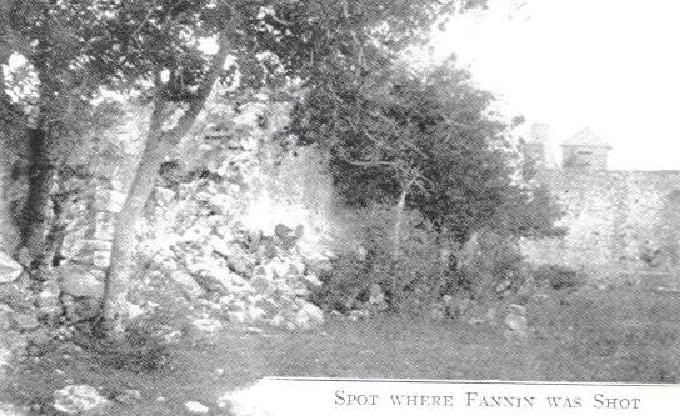

THE GOLIAD MASSACRE (from the Handbook of Texas History)
On the whole, that in shooting these prisoners, Mexico was acting within its rights. Believing that he had found an effective deterrent to expected American help for Texas, Santa Anna sought and obtained from the Mexican Congress the decree of December 30, 1835, which directed that all foreigners taken in arms against the government should be treated as pirates and shot.
Santa Anna's main army took no prisoners; execution of the murderous decree of December 30, 1835, fell to Gen. José de Urrea, commander of Santa Anna's right wing. The first prisoners taken by Urrea were the survivors of Francis W. Johnson' party, captured at and near San Patricio on February 27, 1836 Urrea, according to his contemporary Reuben M. Potter, "was not blood thirsty and when not overruled by orders of a superior, or stirred by irritation, was disposed to treat prisoners with lenity." When the Mexican general reported to Santa Anna that he was holding the San Patricio prisoners, Santa Anna ordered Urrea to comply with the decree of December 30. Urrea complied to the extent of issuing an order to shoot his prisoners, along with those captured in the battle of Agua Dulce Creek, but he had no stomach for such cold-blooded killing; and when Father Thomas J. Malloy, priest of the Irish colonists, protested the execution, Urrea remitted the prisoners to Matamoros, asking Santa Anna's pardon for having done so and washing his hands of their fate.
At Refugio on March 15, 1836, Urrea was again confronted with the duty of complying with the fatal decree of December 30. Thirty-three Americans were captured in the course of the fighting at Nuestra Señora del Refugio Mission, half of them with Capt. Amon B. King's company, the others "one by one". King and his men had infuriated their enemies by burning local ranchos and shooting eight Mexicans seated around a campfire, and these enemies were clamoring for vengeance. Urrea satisfied his conscience by shooting King and fourteen of his men, while "setting at liberty all who were colonists or Mexicans."

A more difficult situation confronted him on March 20 after James W. Fannin's surrender. Fannin's men had agreed upon and reduced to writing the terms upon which they proposed to capitulate. The gist of these was that Fannin and his men, including his officers and the wounded, should be treated as prisoners of war according to the usages of civilized nations and, as soon as possible, paroled and returned to the United States. In view of Santa Anna's positive orders, Urrea could not, of course, accede to these terms, but refusing them would mean another bloody battle. Fannin's men possessed, besides their rifles, 500 spare muskets and nine brass cannons and, if told that it would mean death to surrender, could sell their lives at fearful cost and might cut their way through Urrea's lines. When the Mexican and Texan commissioners seeking surrender terms failed to agree, Urrea shortened the conference by dealing directly with Fannin and proposing written terms, under which the Texans should give up their arms and become prisoners of war "at the disposal of the Supreme Mexican Government." He assured Fannin that there was no known instance where a prisoner of war who had trusted to the clemency of the Mexican government had lost his life, that he would recommend to General Santa Anna acceptance of the terms proposed by Fannin's men, and that he was confident of obtaining Santa Anna's approval within a period of eight days. Fannin, who could not have done much else-Urrea had received reinforcements and artillery that would have devastated the Texan position in an open prairie on ground lower than the Mexican lines-accepted Urrea's proposals but did not inform his men of the conditional nature of these terms. On the other hand, Maj. Juan José Holsinger, one of the Mexican commissioners, lulled their suspicions by entering the Texan lines with the greeting, "Well, gentlemen! In eight days, home and liberty!"
Fannin's men delivered up their arms, and some 230 or 240 uninjured or slightly wounded men were marched back to Goliad and imprisoned in the chapel of Nuestra Señora de Loreto Presidio at La Bahía,qv the fort they had previously occupied. The wounded Texans, about fifty (some estimates are much higher) including doctors and orderlies, Colonel Fannin among them, were returned to Goliad over the next two days. On March 22 William Ward, who with Amon B. King had been defeated in the battle of Refugio, surrendered near Dimitt's Landing on the terms accorded Fannin, and he and about eighty of his men of the Georgia Battalion were added to the Goliad prisoners on March 25. Urrea, in compliance with his promise, wrote to Santa Anna from Guadalupe Victoria, informing him that Fannin and his men were prisoners of war "at the disposal of the Supreme Mexican Government" and recommending clemency; but he reported nothing in his letter of the terms that Fannin and his men had drafted for their surrender.
Santa Anna replied to Urrea's clemency letter on March 23 by ordering immediate execution of these "perfidious foreigners" and repeated the order in a letter the next day. Meantime, on March 23, evidently doubting Urrea's willingness to serve as executioner, Santa Anna sent a direct order to the "Officer Commanding the Post of Goliad" to execute the prisoners in his hands. This order was received on March 26 by Col. José Nicolás de la Portilla, whom Urrea had left at Goliad. Two hours later Portilla received another order, this one from Urrea, "to treat the prisoners with consideration, and especially their leader, Fannin," and to employ them in rebuilding the town. But when he wrote this seemingly humane order, Urrea well knew that Portilla would not be able to comply with it, for on March 25, after receiving Santa Anna's letter, Urrea had ordered reinforcements that would have resulted in too large a diminution of the garrison for the prisoners to be employed on public works.
Portilla suffered an unquiet night weighing these conflicting orders, but he concluded that he was bound to obey Santa Anna's order and directed that the prisoners be shot at dawn. At sunrise on Palm Sunday, March 27, 1836, the unwounded Texans were formed into three groups under heavy guard commanded by Capt. Pedro (Luis?) Balderas, Capt. Antonio Ramírez, and first adjutant Agustín Alcérrica (a colonel in the Tres Villas Battalion in April 1836). The largest group, including what remained of Ward's Georgia Battalion and Capt. Burr H. Duval's company, was marched toward the upper ford of the San Antonio River on the Bexar road. The San Antonio Greys, Mobile Greys, and others were marched along the Victoria road in the direction of the lower ford. Capt. John Shackelford's Red Rovers and Ira J. Westover's regulars were marched southwestwardly along the San Patricio road. The guard, which was to serve also as a firing squad, included the battalions of Tres Villas and Yucatán, dismounted cavalry, and pickets from the Cuautla, Tampico, and Durango regiments.
The prisoners held little suspicion of their fate, for they had been told a variety of stories-they were to gather wood, drive cattle, be marched to Matamoros, or proceed to the port of Copano for passage to New Orleans. Only the day before, Fannin himself, with his adjutant general, Joseph M. Chadwick, had returned from Copano, where, accompanied by Holsinger and other Mexican officers, they had tried to charter the vessel on which William P. Miller's Nashville Battalion had arrived earlier (these men had been captured and imprisoned at Goliad, also). Although this was really an attempt by Urrea to commandeer the ship, the vessel had already departed. Still, Fannin became cheerful and reported to his men that the Mexicans were making arrangements for their departure. The troops sang "Home Sweet Home" on the night of March 26.
At selected spots on each of the three roads, from half to three-fourths of a mile from the presidio, the three groups were halted. The guard on the right of the column of prisoners then countermarched and formed with the guard on the left. At a prearranged moment, or upon a given signal, the guards fired upon the prisoners at a range too close to miss. Nearly all were killed at the first fire. Those not killed were pursued and slaughtered by gunfire, bayonet, or lance. Fannin and some forty (Peña estimated eighty or ninety) wounded Texans unable to march were put to death within the presidio under the direction of Capt. Carolino Huerta of the Tres Villas battalion.
From two groups shot on the river roads, those not instantly killed fled to the woods along the stream, and twenty-four managed to escape. The third group, on the San Patricio road, was farther from cover; only four men from it are known to have escaped. A man-by-man study of Fannin's command indicates that 342 were executed at Goliad on March 27. Only twenty-eight escaped the firing squads, and twenty more were spared as physicians, orderlies, interpreters, or mechanics largely because of the entreaties of a "high bred beauty" whom the Texans called the "Angel of Goliad", and the brave and kindly intervention of Col. Francisco Garay. Many of those who eventually escaped were first recaptured and later managed a second escape. Two physicians, Joseph H. Barnard and John Shackelford, were taken to San Antonio to treat Mexican wounded from the battle of the Alamo; they later escaped.
Portilla wrote that the total number of his prisoners was 445, exclusive of William P. Miller's eighty men, who had been captured without arms at Copano and were thus to be spared. Texan sources specify the number of prisoners as 407, exclusive of Miller's men. This may have been correct. Some of the prisoners taken at Refugio but not executed with King's men are known to have been at Goliad, where they were again spared because they were serving the Mexican army as blacksmiths, wheelwrights, or other artisans. The exact fate of others captured at Refugio is not known. They may have been added to the prisoners at Goliad and killed with Fannin on March 27. Urrea detained about twenty of Ward's men to build boats at Guadalupe Victoria, and Señora Alavez intervened with her husband, Col. Telesforo Alavez, whom Urrea left in charge of this village, to spare their lives as well; they afterward escaped. About a week after the Goliad killings, Santa Anna ordered the execution of Miller and his men and the others who had been spared at Goliad, but he rescinded the order the next day. The men were marched instead to Matamoros after the battle of San Jacinto. Though some managed to escape en route, most remained there until the Mexican government later released them.
After the executions the bodies were burned, the remains left exposed to weather, vultures, and coyotes, until June 3, 1836, when Gen. Thomas J. Rusk, who had established his headquarters at Victoria after San Jacinto and was passing through Goliad in pursuit of Gen. Vicente Filisola'sqv retreating army, gathered the remains and buried them with military honors. Some of the survivors attended the ceremony.
The common grave remained unmarked until about 1858, when a Goliad merchant, George von Dohlen, placed a pile of rocks on what was believed to be the site. In April 1885 a memorial was finally erected, in the city of Goliad rather than on the site, by the Fannin Monument Association, formed by William L. Hunter, a massacre survivor. In 1930 some Goliad Boy Scouts found charred bone fragments that had been unearthed over the years by animals, and an excursion to the site by Goliad residents on New Year's Day, 1932, succeeded in attracting an investigation of the site by University of Texas anthropologist J. E. Pearce. The authenticity of the gravesite was further verified by historians Clarence R. Wharton and Harbert Davenport.qqv In 1936, in celebration of the Texas Centennial, money was appropriated to build a massive pink granite monument, dedicated on June 4, 1938.
The impact of the Goliad Massacre was crucial. Until this episode Santa Anna's reputation had been that of a cunning and crafty man, rather than a cruel one. When the Goliad prisoners were taken, Texas had no other army in the field, and the newly constituted ad interim governmentqv seemed incapable of forming one. The Texas cause was dependent on the material aid and sympathy of the United States. Had Fannin's and Miller's men been dumped on the wharves at New Orleans penniless, homesick, humiliated, and distressed, and each with his separate tale of Texas mismanagement and incompetence, Texas prestige in the United States would most likely have fallen, along with sources of help. But Portilla's volleys at Goliad, together with the fall of the Alamo, branded both Santa Anna and the Mexican people with a reputation for cruelty and aroused the fury of the people of Texas, the United States, and even Great Britain and France, thus considerably promoting the success of the Texas Revolution.


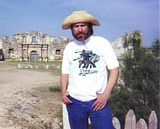

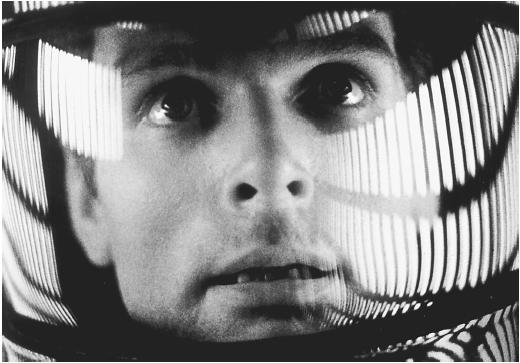
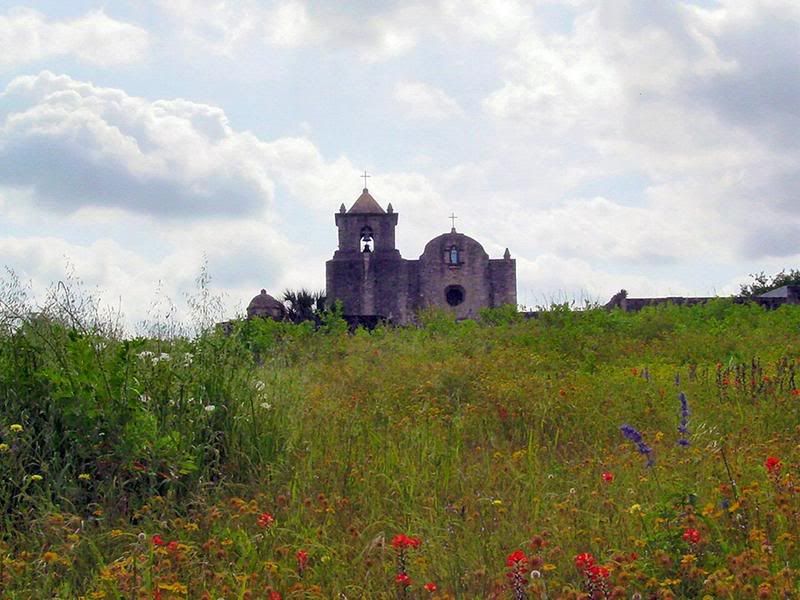


 It has pieces written by:
It has pieces written by: It is also from the informative link below!
It is also from the informative link below!
